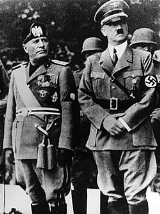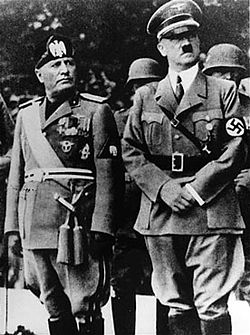
The Rome-Berlin Axis
Encyclopedia
The Rome-Berlin Axis is a 1949 book by British
historian
Elizabeth Wiskemann
. It is a study of the Axis alliance
of Fascist Italy
and Nazi Germany
with particular emphasis on the relationship between Benito Mussolini
and Adolf Hitler
.
 It was published by Oxford University Press
It was published by Oxford University Press
as a 376-page hardcover in 1949. Collins
(London
) published a 446-page revised edition in 1966.
United Kingdom
The United Kingdom of Great Britain and Northern IrelandIn the United Kingdom and Dependencies, other languages have been officially recognised as legitimate autochthonous languages under the European Charter for Regional or Minority Languages...
historian
Historian
A historian is a person who studies and writes about the past and is regarded as an authority on it. Historians are concerned with the continuous, methodical narrative and research of past events as relating to the human race; as well as the study of all history in time. If the individual is...
Elizabeth Wiskemann
Elizabeth Wiskemann
Elizabeth Wiskemann was an English journalist and historian of Anglo-German ancestry.-Life and work:Elizabeth Meta Wiskemann was born in Sidcup, Kent, on 13 August 1899, the youngest child of Heinrich Odomar Hugo Wiskemann and his wife Emily Burton. She was educated at Notting Hill High School...
. It is a study of the Axis alliance
Axis Powers
The Axis powers , also known as the Axis alliance, Axis nations, Axis countries, or just the Axis, was an alignment of great powers during the mid-20th century that fought World War II against the Allies. It began in 1936 with treaties of friendship between Germany and Italy and between Germany and...
of Fascist Italy
Kingdom of Italy (1861–1946)
The Kingdom of Italy was a state forged in 1861 by the unification of Italy under the influence of the Kingdom of Sardinia, which was its legal predecessor state...
and Nazi Germany
Nazi Germany
Nazi Germany , also known as the Third Reich , but officially called German Reich from 1933 to 1943 and Greater German Reich from 26 June 1943 onward, is the name commonly used to refer to the state of Germany from 1933 to 1945, when it was a totalitarian dictatorship ruled by...
with particular emphasis on the relationship between Benito Mussolini
Benito Mussolini
Benito Amilcare Andrea Mussolini was an Italian politician who led the National Fascist Party and is credited with being one of the key figures in the creation of Fascism....
and Adolf Hitler
Adolf Hitler
Adolf Hitler was an Austrian-born German politician and the leader of the National Socialist German Workers Party , commonly referred to as the Nazi Party). He was Chancellor of Germany from 1933 to 1945, and head of state from 1934 to 1945...
.

Oxford University Press
Oxford University Press is the largest university press in the world. It is a department of the University of Oxford and is governed by a group of 15 academics appointed by the Vice-Chancellor known as the Delegates of the Press. They are headed by the Secretary to the Delegates, who serves as...
as a 376-page hardcover in 1949. Collins
HarperCollins
HarperCollins is a publishing company owned by News Corporation. It is the combination of the publishers William Collins, Sons and Co Ltd, a British company, and Harper & Row, an American company, itself the result of an earlier merger of Harper & Brothers and Row, Peterson & Company. The worldwide...
(London
London
London is the capital city of :England and the :United Kingdom, the largest metropolitan area in the United Kingdom, and the largest urban zone in the European Union by most measures. Located on the River Thames, London has been a major settlement for two millennia, its history going back to its...
) published a 446-page revised edition in 1966.
Contents
- Introduction
- Note on Sources
- I. Pupils of Nietzsche
- II The Quarrel over AustriaAustrian Civil WarThe Austrian Civil War , also known as the February Uprising , is a term sometimes used for a few days of skirmishes between socialist and conservative-fascist forces between 12 February and 16 February 1934, in Austria...
- III. Germany and the Attack upon Abyssinia
- IV. 'This Berlin-Rome Line is not a Diaphragm but rather an AxisMetaphorA metaphor is a literary figure of speech that uses an image, story or tangible thing to represent a less tangible thing or some intangible quality or idea; e.g., "Her eyes were glistening jewels." Metaphor may also be used for any rhetorical figures of speech that achieve their effects via...
' - V. The DuceDuceDuce is an Italian title, derived from the Latin word dux, and cognate with duke. National Fascist Party leader Benito Mussolini was identified by Fascists as Il Duce of the movement and became a reference to the dictator position of Head of Government and Duce of Fascism of Italy was established...
in Germany - VI. Austria Lost and Won
- VII. The FührerFührerFührer , alternatively spelled Fuehrer in both English and German when the umlaut is not available, is a German title meaning leader or guide now most associated with Adolf Hitler, who modelled it on Benito Mussolini's title il Duce, as well as with Georg von Schönerer, whose followers also...
in Italy
- VIII. Mediation at MunichMunich AgreementThe Munich Pact was an agreement permitting the Nazi German annexation of Czechoslovakia's Sudetenland. The Sudetenland were areas along Czech borders, mainly inhabited by ethnic Germans. The agreement was negotiated at a conference held in Munich, Germany, among the major powers of Europe without...
- IX. The Steel PactPact of SteelThe Pact of Steel , known formally as the Pact of Friendship and Alliance between Germany and Italy, was an agreement between Fascist Italy and Nazi Germany signed on May 22, 1939, by the foreign ministers of each country and witnessed by Count Galeazzo Ciano for Italy and Joachim von Ribbentrop...
- X. 'To attack PolandPolandPoland , officially the Republic of Poland , is a country in Central Europe bordered by Germany to the west; the Czech Republic and Slovakia to the south; Ukraine, Belarus and Lithuania to the east; and the Baltic Sea and Kaliningrad Oblast, a Russian exclave, to the north...
at the First Suitable Opportunity' - XI. The Axis Shaken
- XII. The Mission of Sumner WellesSumner WellesBenjamin Sumner Welles was an American government official and diplomat in the Foreign Service. He was a major foreign policy adviser to President Franklin D. Roosevelt and served as Under Secretary of State from 1937 to 1943, during FDR's presidency.-Early life:Benjamin Sumner Welles was born in...
- XIII. Mussolini Declares War
- XIV. The Attack upon GreeceGreco-Italian WarThe Greco-Italian War was a conflict between Italy and Greece which lasted from 28 October 1940 to 23 April 1941. It marked the beginning of the Balkans Campaign of World War II...
- XV. The Axis and FrancoFrancisco FrancoFrancisco Franco y Bahamonde was a Spanish general, dictator and head of state of Spain from October 1936 , and de facto regent of the nominally restored Kingdom of Spain from 1947 until his death in November, 1975...
- XVI. Operations Marita and BarbarossaOperation BarbarossaOperation Barbarossa was the code name for Germany's invasion of the Soviet Union during World War II that began on 22 June 1941. Over 4.5 million troops of the Axis powers invaded the USSR along a front., the largest invasion in the history of warfare...
- XVII. The New OrderNew Order (political system)The New Order or the New Order of Europe was the political order which the Nazis wanted to impose on Europe, and eventually the rest of the world, during their reign over Germany from 1933 to 1945...
- XVIII. Italy Rebels
- XIX. 'MésallianceMesallianceA mesalliance is a marriage with a person of inferior social position....
' - XX. Nazis and Neo-Fascists
- XXI. Epilogue
- Bibliography
- Appendix: The Steel Pact
- Indexes: (A) Persons (with biographical notes)
-
- (B) Subjects and Places
External links
- Review of The Rome-Berlin Axis by Raymond J. Sontag in American Historical ReviewAmerican Historical ReviewThe American Historical Review is the official publication of the American Historical Association, established in 1895 "for the promotion of historical studies, the collection and preservation of historical documents and artifacts, and the dissemination of historical research." It targets readers...
, Vol. 55, No. 1 (Oct., 1949), pp. 139-140. - Review of The Rome-Berlin Axis by Eric C. Kollman in The Journal of Modern HistoryThe Journal of Modern HistoryThe Journal of Modern History is a quarterly peer-reviewed academic journal covering European intellectual, political, and cultural history, published by the University of Chicago Press in cooperation with the Modern European History Section of the American Historical Association...
, Vol. 23, No. 2 (1951), pp. 177-178. - Review of The Rome-Berlin Axis by Beatrice McCown Mattison in The American Political Science Review, Vol. 43, No. 5 (1949), pp. 1048-1049.
- Review of The Rome-Berlin Axis by Martin WightMartin WightRobert James Martin Wight , also known as Martin Wight, was one of the foremost British scholars of International Relations in the twentieth century...
in International AffairsInternational Affairs (journal)International Affairs is Britain's leading peer-reviewed academic journal of international relations founded by Chatham House in 1924. It is published bi-monthly by Wiley-Blackwell . Currently its editor-in-chief is Caroline Soper...
, Vol. 25, No. 3 (Jul., 1949), pp. 370-371.

